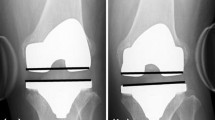Abstract
Purpose
We evaluated 3- to 6-year clinical and radiological follow-up results after NexGen® LPS-flex total knee arthroplasty (TKA).
Methods
A retrospective evaluation was undertaken of 218 knees in 166 patients (22 males, 144 females) who were followed up for more than 3 years after TKA. Evaluations included preoperative and postoperative range of motion (ROM) measurement, Knee Society (KS) Score, tibiofemoral angle and assessment of postoperative complications.
Results
TKA resulted in a significant ROM increase from a mean flexion contracture of 9° (range 0°–20°) and further flexion of 117° (range 80°–155°) to a mean flexion contracture of 2° (range 0°–10°) and a further flexion of 131° (range 95°–155°). KS knee and function scores significantly improved from 52 and 38 before surgery to 87 and 82 after surgery, respectively. The tibiofemoral angle significantly improved from varus 5.7° to valgus 5.4°. Progressive radiolucent lines around the femoral component on radiographs were observed in 30 knees (13.8%, 27 patients), and more of those knees, could squat than non-radiolucent knees (76.7 vs. 20.2%; P < 0.05). Seven knees (3.2%, 6 patients) were revised at a mean 49 months after the index operation.
Conclusions
While NexGen® LPS-flex TKA satisfactorily improved ROM, it was associated with a relatively high incidence of early loosening of the femoral components. This might be associated with passive-maximal flexion activity, such as squatting or kneeling. The clinical relevance of this study is that squatting or kneeling, common activity in Asian, may not be allowed after NexGen® LPS-flex TKA.


Similar content being viewed by others
References
Anouchi YS, McShane M, Kelly F Jr, Elting J, Stiehl J (1996) Range of motion in total knee replacement. Clin Orthop Relat Res 331:87–92
Banks S, Bellemans J, Nozaki H, Whiteside LA, Harman M, Hodge WA (2003) Knee motions during maximum flexion in fixed and mobile-bearing arthroplasties. Clin Orthop Relat Res 410:131–138
Bin SI, Nam TS (2007) Early results of high-flex total knee arthroplasty: comparison study at 1 year after surgery. Knee Surg Sports Traumatol Arthrosc 15:350–355
Chew JT, Stewart NJ, Hanssen AD, Luo ZP, Rand JA, An KN (1997) Differences in patellar tracking and knee kinematics among three different total knee designs. Clin Orthop Relat Res 345:87–98
Dennis DA, Komistek RD, Stiehl JB, Walker SA, Dennis KN (1998) Range of motion after total knee arthroplasty: the effect of implant design and weight-bearing conditions. J Arthroplasty 13:748–752
D’Lima DD, Steklov N, Fregly BJ, Banks SA, Colwell CW Jr (2008) In vivo contact stresses during activities of daily living after knee arthroplasty. J Orthop Res 26:1549–1555
Han HS, Kang SB, Yoon KS (2007) High incidence of loosening of the femoral component in legacy posterior stabilised-flex total knee replacement. J Bone Joint Surg Br 89:1457–1461
Huang HT, Su JY, Wang GJ (2005) The early results of high-flex total knee arthroplasty: a minimum of 2 years of follow-up. J Arthroplasty 20:674–679
Insall J, Scott WN, Ranawat CS (1979) The total condylar knee prosthesis. A report of two hundred and twenty cases. J Bone Joint Surg Am 61:173–180
Kim TH, Lee DH, Bin SI (2008) The NexGen LPS-flex to the knee prosthesis at a minimum of three years. J Bone Joint Surg Br 90:1304–1310
Kim TK, Kwon SK, Kang YG, Chang CB, Seong SC (2010) Functional disabilities and satisfaction after total knee arthroplasty in female Asian patients. J Arthroplasty 25:458–464
Kim YH, Sohn KS, Kim JS (2005) Range of motion of standard and high-flexion posterior stabilized total knee prosthesis. A prospective, randomized study. J Bone Joint Surg Am 87:1470–1475
King TV, Scott RD (1985) Femoral component loosening in total knee arthroplasty. Clin Orthop Relat Res 194:285–290
Kurosaka M, Yoshiya S, Mizuno K, Yamamoto T (2002) Maximizing flexion after total knee arthroplasty: the need and the pitfalls. J Arthroplasty 17:59–62
Long WJ, Scuderi GR (2008) High-flexion total knee arthroplasty. J Arthroplasty 23:6–10
Mulholland SJ, Wyss UP (2001) Activities of daily living in non-Western cultures: range of motion requirements for hip and knee joint implants. Int J Rehabil Res 24:191–198
Nagura T, Dyrby CO, Alexander EJ, Andriacchi TP (2002) Mechanical loads at the knee joint during deep flexion. J Orthop Res 20:881–886
Nakayama K, Matsuda S, Miura H, Iwamoto Y, Higaki H, Otsuka K (2005) Contact stress at the post-cam mechanism in posterior-stabilised total knee arthroplasty. J Bone Joint Surg Br 87:483–488
Park KK, Shin KS, Chang CB, Kim SJ, Kim TK (2007) Functional disabilities and issues of concern in female Asian patients before TKA. Clin Orthop Relat Res 461:143–152
Ritter MA, Campbell ED (1987) Effect of range of motion on the success of a total knee arthroplasty. J Arthroplasty 2:95–97
Thambyah A, Goh JC, De SD (2005) Contact stresses in the knee joint in deep flexion. Med Eng Phys 27:329–335
Author information
Authors and Affiliations
Corresponding author
Rights and permissions
About this article
Cite this article
Cho, SD., Youm, YS. & Park, KB. Three- to six-year follow-up results after high-flexion total knee arthroplasty: can we allow passive deep knee bending?. Knee Surg Sports Traumatol Arthrosc 19, 899–903 (2011). https://doi.org/10.1007/s00167-010-1218-x
Received:
Accepted:
Published:
Issue Date:
DOI: https://doi.org/10.1007/s00167-010-1218-x




